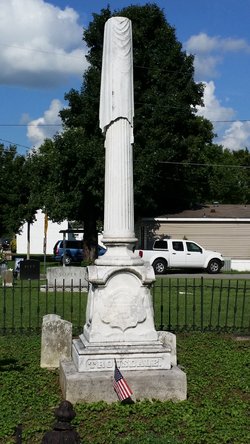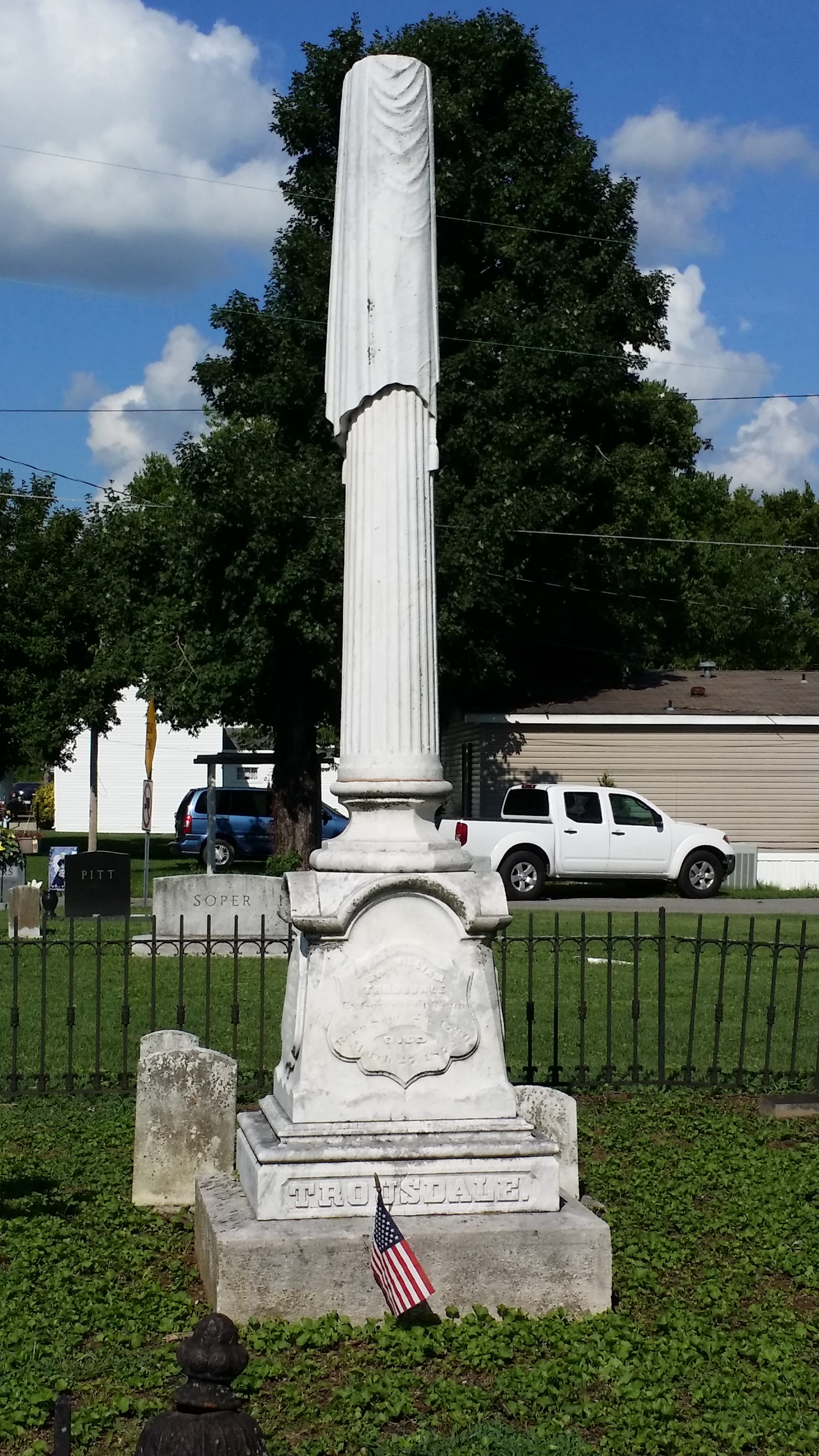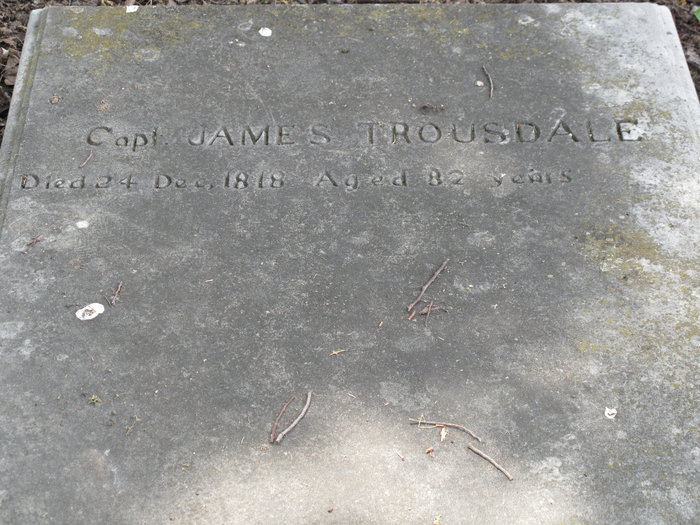"James was a soldier in the Revolutionary War. He commanded a company of North Carolina patriots. He was severely wounded and until his death he carried a scar made by a saber in the hands of one of Tarleton's men. He served throughout the war and was with Washington at Yorktown.
For his service, Captain James Trousdale, in 1779, received first 200 acres of land in North Carolina (NC Land Grant XL929) and later 640 acres of land situated in what was then Davidson County, now Sumner County, Tennessee. This land was paid for in scrip or certificates issued by North Carolina to him for services in the war for independence.
James Trousdale moved from North Carolina and settled on this tract of land in 1796. The land was then covered by a dense forest. Here he cleared land and began to cultivate the soil. But, on the 6th of November, 1801, the Legislature of Tennessee appointed commissioners to select and purchase land upon which to lay out a town to be named Gallatin, which was to be the county seat of Sumner County. The commissioners selected the farm of Captain James Trousdale, and the town of Gallatin now stands upon the old Trousdale farm.
He left a large family. One son, James, moved to Illinois at an early date (married Melinda May, they had ten children). One named Robert moved to St. Mary's Parish, Louisiana. The descendants of another son went to Indiana. Captain Matthew Cowan married Katie, a daughter of Captain James Trousdale. Captain Cowan lived in Putnam County, Tennessee, and he has descendants in Smith, Jackson and Putnam Counties, Tennessee." The American Historical Magazine, Vol. 7, No. 4, (October 1902), pp. 311-315, By B. F. Allen, Gallatin, Tenn.
In his will he left the majority of the estate to his wife Elizabeth and sons William and Bryson including 4 slaves: Bill, Penny, Lo and Delia. September 1818, copy on file at the Wisconsin Historical Society Library, Madison, WI
"It is believed that James was an unnamed member of the ill-fated rebels at the battle of the Alamance on 16 May 1771. B.F. Allen, who married a granddaughter of Capt. James, writing of the latter service during the Revolution, included this engagement with those of the War of the Revolution, Allen not realizing the historic significance.
In the Revolution, again quoting Allen, James Trousdale began his active military service as a captain of militia in 1779, was captured at Charleston (actually he was captured at Hillsborough), served with Marion (the Swamp Fox), was severely wounded by a saber cut received from one of Commander Tarleton's troopers at Guilford Court House (15 Mch 1781) and he and his company was at Yorktown for Cornwallis's surrender, 19 Oct 1781. (Am Hist Mag VII 4)." Trousdale Genealogy" by Karl Truesdell
He is listed in the DAR Patriot Index, Centennial Edition on page 2981, and the DAR Patriot Index on page 689.
SARS record found on Ancestry.com: "James Trousdale served under Gen. Francis Marion and commanded a North Carolina militia which guarded the jail at Hillsboro and was present at the siege of Charleston (actually he wasn't present at the Siege of Charleston, but was at the Battle of Guilford Courthouse). The grant of land given him for his services is now in the possession of his descendant and his tomb stands near the old house in Gallatin where he died in 1818 at the age of eighty-two. "
James Trousdale, Orange County Regiment: Was a Lieutenant, 1779-1780, a Captain under Lt. Col. Archibald Lytle (a Continental office) when Capt. William O'Neal was promoted to Major. Marched to Charleston, SC and built a lot of breastworks, etc., discharged on March 24, 1780, before the town surrendered. Then, a Captain under Col. William O'Neal. 1781, a Captain under Col. James Read (NC Light Horse Regiment). POW at Hillsborough on 9/12/1781. 1782, a Captain under Maj. Edward Gwinn and Col. William O'Neal. Captain Trousdale took over William O'Neal's company when O'Neal was promoted to Major, in late 1779. Source: The American Revolution in North Carolina: https://www.carolana.com/NC/Revolution/nc_patriot_military_captains.html
In the Battle of Hillsborough, 12 Sep 1780, Capt. Trousdale was taken prisoner but later paroled. "Col. David Fanning and his Loyalist regiment took nearly 200 prisoners on that day. Included in Fanning's prisoners were Col. James Read, Capt. Thomas Thompson, and Capt. James Trousdale of the NC Light Horse Regiment." Source: The American Revolution in North Carolina: https://www.carolana.com/NC/Revolution/nc_light_horse_regiment.html
The Battle at Guilford Courthouse: On March 15, 1781, British General Charles Lord Cornwallis's army of 2,100 men engaged a Continental army under Major General Nathanael Greene at Guilford Court House, near present-day Greensboro, North Carolina. Guilford Courthouse was a pyrrhic victory for Cornwallis. Despite besting the American army, he had lost 25% of his men and was in no position to pursue Greene. Cornwallis decided to withdraw to his supply base at Wilmington to rest and refit. With his army still not in condition to engage Greene by the middle of April, Cornwallis decided to shift his operations to Virginia, a decision that would contribute to the independence of the United States. American Commander, Nathaniel Green; British Commander, Charles Cornwallis. Estimated casualties from both sides: 1,842. https://www.battlefields.org/learn/revolutionary-war/battles/guilford-court-house
"James was a soldier in the Revolutionary War. He commanded a company of North Carolina patriots. He was severely wounded and until his death he carried a scar made by a saber in the hands of one of Tarleton's men. He served throughout the war and was with Washington at Yorktown.
For his service, Captain James Trousdale, in 1779, received first 200 acres of land in North Carolina (NC Land Grant XL929) and later 640 acres of land situated in what was then Davidson County, now Sumner County, Tennessee. This land was paid for in scrip or certificates issued by North Carolina to him for services in the war for independence.
James Trousdale moved from North Carolina and settled on this tract of land in 1796. The land was then covered by a dense forest. Here he cleared land and began to cultivate the soil. But, on the 6th of November, 1801, the Legislature of Tennessee appointed commissioners to select and purchase land upon which to lay out a town to be named Gallatin, which was to be the county seat of Sumner County. The commissioners selected the farm of Captain James Trousdale, and the town of Gallatin now stands upon the old Trousdale farm.
He left a large family. One son, James, moved to Illinois at an early date (married Melinda May, they had ten children). One named Robert moved to St. Mary's Parish, Louisiana. The descendants of another son went to Indiana. Captain Matthew Cowan married Katie, a daughter of Captain James Trousdale. Captain Cowan lived in Putnam County, Tennessee, and he has descendants in Smith, Jackson and Putnam Counties, Tennessee." The American Historical Magazine, Vol. 7, No. 4, (October 1902), pp. 311-315, By B. F. Allen, Gallatin, Tenn.
In his will he left the majority of the estate to his wife Elizabeth and sons William and Bryson including 4 slaves: Bill, Penny, Lo and Delia. September 1818, copy on file at the Wisconsin Historical Society Library, Madison, WI
"It is believed that James was an unnamed member of the ill-fated rebels at the battle of the Alamance on 16 May 1771. B.F. Allen, who married a granddaughter of Capt. James, writing of the latter service during the Revolution, included this engagement with those of the War of the Revolution, Allen not realizing the historic significance.
In the Revolution, again quoting Allen, James Trousdale began his active military service as a captain of militia in 1779, was captured at Charleston (actually he was captured at Hillsborough), served with Marion (the Swamp Fox), was severely wounded by a saber cut received from one of Commander Tarleton's troopers at Guilford Court House (15 Mch 1781) and he and his company was at Yorktown for Cornwallis's surrender, 19 Oct 1781. (Am Hist Mag VII 4)." Trousdale Genealogy" by Karl Truesdell
He is listed in the DAR Patriot Index, Centennial Edition on page 2981, and the DAR Patriot Index on page 689.
SARS record found on Ancestry.com: "James Trousdale served under Gen. Francis Marion and commanded a North Carolina militia which guarded the jail at Hillsboro and was present at the siege of Charleston (actually he wasn't present at the Siege of Charleston, but was at the Battle of Guilford Courthouse). The grant of land given him for his services is now in the possession of his descendant and his tomb stands near the old house in Gallatin where he died in 1818 at the age of eighty-two. "
James Trousdale, Orange County Regiment: Was a Lieutenant, 1779-1780, a Captain under Lt. Col. Archibald Lytle (a Continental office) when Capt. William O'Neal was promoted to Major. Marched to Charleston, SC and built a lot of breastworks, etc., discharged on March 24, 1780, before the town surrendered. Then, a Captain under Col. William O'Neal. 1781, a Captain under Col. James Read (NC Light Horse Regiment). POW at Hillsborough on 9/12/1781. 1782, a Captain under Maj. Edward Gwinn and Col. William O'Neal. Captain Trousdale took over William O'Neal's company when O'Neal was promoted to Major, in late 1779. Source: The American Revolution in North Carolina: https://www.carolana.com/NC/Revolution/nc_patriot_military_captains.html
In the Battle of Hillsborough, 12 Sep 1780, Capt. Trousdale was taken prisoner but later paroled. "Col. David Fanning and his Loyalist regiment took nearly 200 prisoners on that day. Included in Fanning's prisoners were Col. James Read, Capt. Thomas Thompson, and Capt. James Trousdale of the NC Light Horse Regiment." Source: The American Revolution in North Carolina: https://www.carolana.com/NC/Revolution/nc_light_horse_regiment.html
The Battle at Guilford Courthouse: On March 15, 1781, British General Charles Lord Cornwallis's army of 2,100 men engaged a Continental army under Major General Nathanael Greene at Guilford Court House, near present-day Greensboro, North Carolina. Guilford Courthouse was a pyrrhic victory for Cornwallis. Despite besting the American army, he had lost 25% of his men and was in no position to pursue Greene. Cornwallis decided to withdraw to his supply base at Wilmington to rest and refit. With his army still not in condition to engage Greene by the middle of April, Cornwallis decided to shift his operations to Virginia, a decision that would contribute to the independence of the United States. American Commander, Nathaniel Green; British Commander, Charles Cornwallis. Estimated casualties from both sides: 1,842. https://www.battlefields.org/learn/revolutionary-war/battles/guilford-court-house







